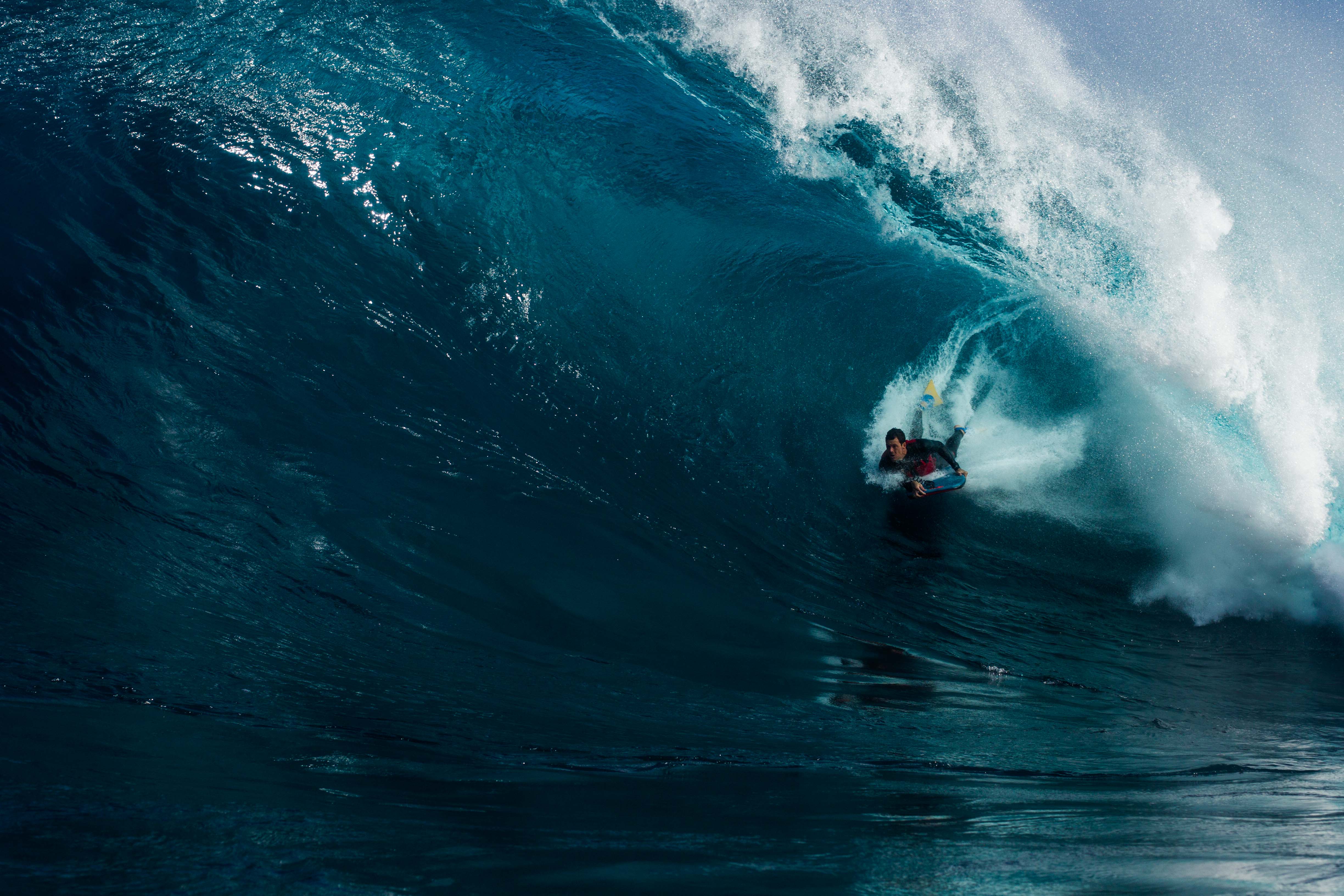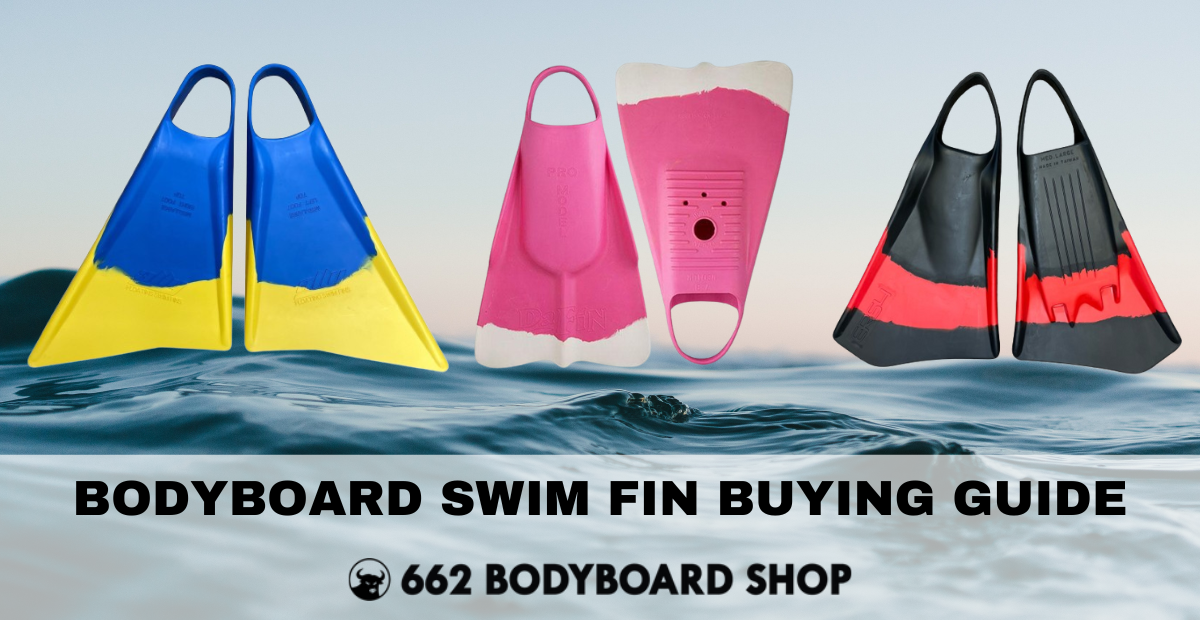Bodyboard Buying Guide: How to Choose, Sizing, & More
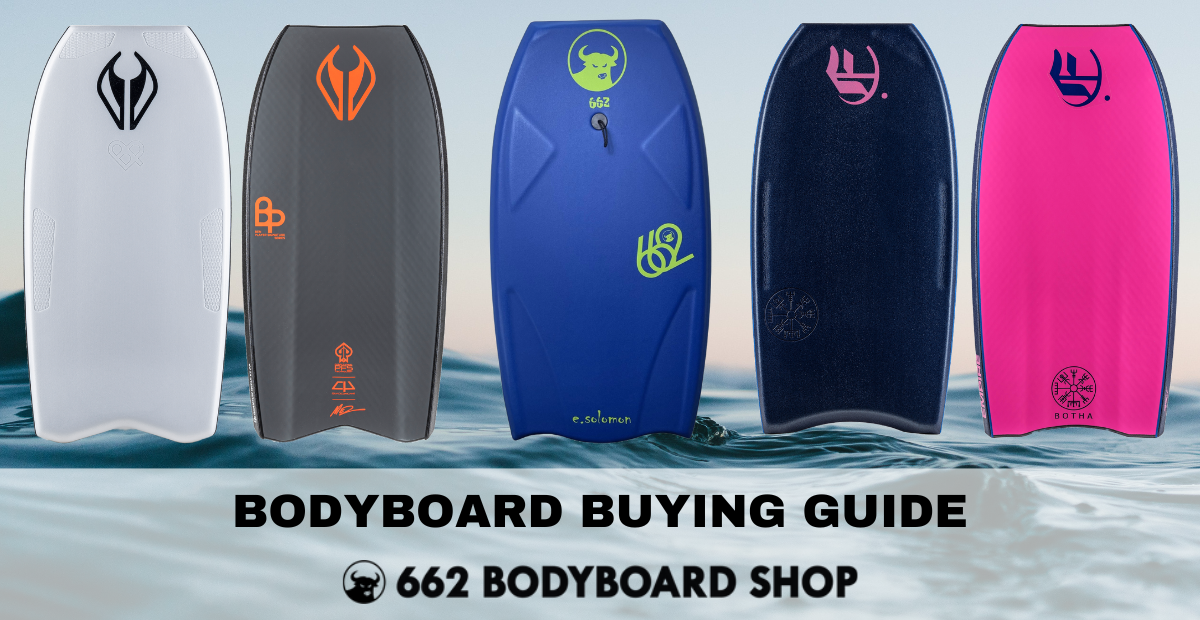
Ready to buy your first bodyboard or looking for a high performance bodyboard to take your riding to the next level? Getting the right bodyboard is the first step towards catching epic waves and enjoying your bodyboarding experience to the fullest.
With so many options on the market, finding the best bodyboard according to your skill level, physical needs, wave conditions, water temperature, and riding style can get confusing. This bodyboard buying guide covers everything beginner, intermediate, and advanced riders need to know about choosing a new bodyboard.
Our Bodyboard Experience
For over 20 years, our staff at 662 Bodyboard Shop have enjoyed educating people on how to choose the best bodyboard for their needs. Our brand was launched in 2003 out of a small garage by Eddie Solomon, a Southern California bodyboarder known for his aggressive, big wave riding at legendary spots like Waimea Shorebreak and The Wedge. For close to ten years, he operated several bodyboard only stores and launched one of the first and most successful online bodyboard shops in existence. Sadly, we lost Eddie far too early but the positive impact he left on the sport will never be forgotten.
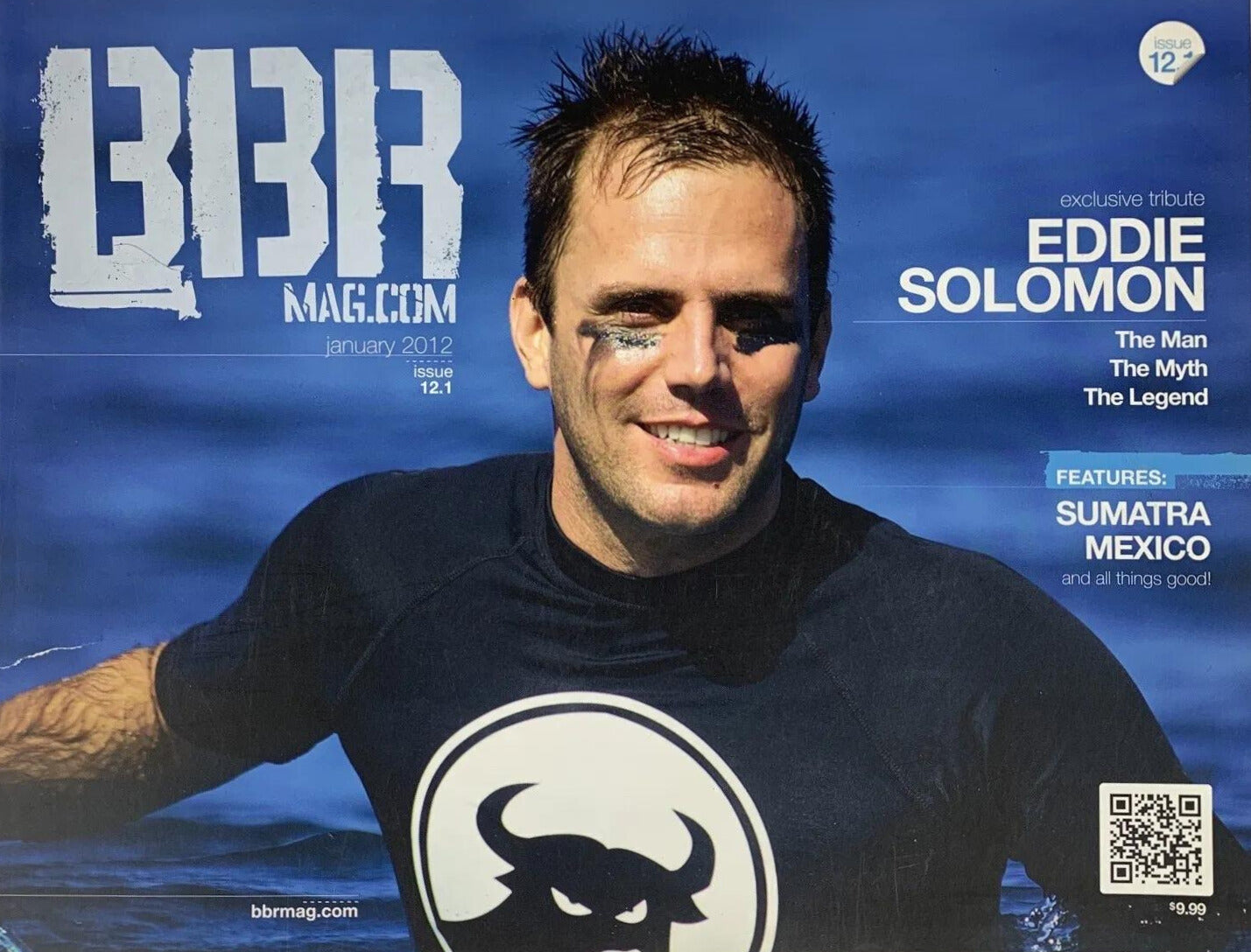
To this day, 662 Bodyboard Shop is 100% family owned and operated in Costa Mesa, CA. We are committed to helping you find the highest quality products from the best brands the bodyboarding industry has to offer. Utilizing these years of experience, we’ve put together this guide to explain everything you need to know about bodyboards. We’ll cover the parts and features of a bodyboard, how they affect your riding experience, and how to select different styles of boards to help ensure that you are having the best time while out in the water!
Table of contents
We try to keep our bodyboard buying guide as fresh and comprehensive as possible. Use the links below to help navigate through sections:- Brief History of Bodyboards & The Boogie Board
- 3 Bodyboard Considerations for Beginners & Kids
- Parts & Features of a Bodyboard
- Bodyboard Riding Styles, Shapes, & Templates
- Bodyboard Sizing Factors
- Bodyboard Size Chart
- Bodyboard Cores
- Bodyboard Tail Shapes
- Bodyboard Stringers
- Bodyboard Stiffeners & Constructions
- Bodyboard Flex & Recoil
- Channel Configurations
- Slick Bottoms
- Rail Configurations
- Top Deck Materials, Contours, & Grips
- Bodyboard Leashes
Brief History of Bodyboards & The Boogie Board
For those beginners out there, you may be wondering what the difference is between a bodyboard and “Boogie Board”. To answer this, we have to start with the origins of modern bodyboarding. Modern bodyboarding can be traced back to 1971 in Hawaii when Tom Morey created the very first bodyboard, originally dubbed the "Boogie Board".
Here’s Tom’s story on why and how he developed his first bodyboard according to the California Surf Museum: “I had no money and the surf was good right off the front yard. I had a leftover piece of polyethylene foam in the garage and I cut out a four-and-a-half board with an electric carving knife. Then I used my wife’s iron and ironed the foam (to seal it) with a copy of the Honolulu Advertiser newspaper. The print from the newspaper transferred to the board, and that’s how I remember the date – July 7, 1971.”

The Boogie Board was an instant hit and the modern sport of bodyboarding was born. This is where the distinction between Boogie Board and bodyboard lies - “Boogie Board” is the brand name from Morey, whereas bodyboard or bodyboarding, is the name of the sport itself.
The construction of bodyboards has come a long way since the 70’s. Manufacturers are producing bodyboards with major advancements in technology, design, and materials to enhance board performance, which we’ll dive into within this guide. Before getting into the nitty gritty of modern bodyboard advancements, let’s cover some basics for those looking for some quick answers on how to purchase their first bodyboard or a bodyboard for kids.
3 Bodyboard Considerations for Beginners & Kids
Modern bodyboards represent decades of innovation in materials science, engineering and wave-riding performance. But if you're a beginner looking to start in smaller waves or if you are shopping for a younger rider, you don't need to know all of the technical details that go into high performance boards.
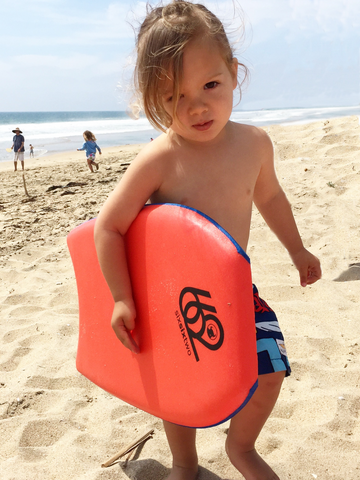
Here are the 3 essential things to consider when choosing the best bodyboard for your physical needs, skill level, and water conditions.
1. Bodyboard Size & Riding Experience
Your body size, riding experience, and the types of waves you will be riding are the three key factors to consider when choosing a bodyboard.
- Be sure to check out our sizing section below to figure out which size bodyboard will best fit your needs. If you have a very small child or toddler wanting to catch some shore waves, mini kick boards, also known as mini bodyboards are a great option.
- If you have some bodyboarding experience and want a longer lasting board with improved performance features, then opting to get an intermediate level board or pro level board rather than a beginner board is ideal. Kids’ boards or beginner boards are great as well for those wanting to see if bodyboarding is right for them. Once you catch a wave though, you’ll likely get hooked on the sport!
- Most beginners are not recommended to attempt riding larger waves, but if you are wanting to do so, be sure to invest in a bodyboard that has a quality core material, offers extra support via stringers or stiffeners, and be sure to go with a trusted brand, which we’ll cover more in a bit.
2. Bodyboard Core
The core of a bodyboard is the foam material that lays in between the bottom of a bodyboard (The slick bottom) and the top deck (What you lay on or ride on).
- There are various types of bodyboard core materials and designs that offer different performance features.
- Different types of core materials are also designed for specific water temperature ranges, making them extremely important for those wanting optimal performance and durability.
- For kids and beginners, bodyboard cores are not as important unless you are a larger rider and are in need of an extra durable board.
3. Bodyboard Brand
The brand of bodyboard that you choose is very important depending on your needs.
- If you are looking for a bodyboard to let your kid use for a single day while on your beach trip, then the no-brand, generic $20 board at the local tourist shop could be a good option.
- If you’re looking for a bodyboard that will last a long time, will not break, peel, or crease after minimal use, and offers some performance benefits, then be sure to invest in a board from a trusted bodyboard brand.
- Most of the time, it’s more cost effective to spend a little more on a bodyboard that will last a long time rather than spending less on a board that will need to be replaced after minimal use. This is especially true for older kids or adults as the wear and tear that larger riders put on their board is generally much greater than young or small riders.
- If you’re shopping for a youth rider that lives near the beach or visits the beach often, then investing in a quality board makes sense as well. Quality boards that are not used excessively and are stored properly should last many years.
- There's nothing worse than debating on two boards, going with a cheap or poor quality option to save a few bucks and then having that board break or bend the first time it hits the water!
We’ll leave it at that for the beginners wanting to find a board quickly. Continue reading on to learn everything you need to know about choosing a high performance bodyboard to meet your needs!
Parts & Features of a Bodyboard
There’s a lot more that goes into building a high quality bodyboard than most people realize. Before getting into the design factors of a bodyboard too deep, let’s do a quick overview of all the parts or features of modern bodyboards.

- Bodyboard Core - Although you don’t see the inside or core of your bodyboard, this is arguably the most important feature of your board. This is because bodyboard cores are made from different types of foam materials that are designed for different use cases. Use cases can vary drastically in the sport of bodyboarding, so cores are designed for specific water temperatures, wave conditions, and to meet different bodyboarder performance preferences.
- The Nose - The nose of a bodyboard is the front or top end of your board. The nose points in the direction in which you are riding. Different bodyboards will have different nose designs and or widths to cater to different riding styles and maneuverability preferences.
- The Tail - The tail of a bodyboard is the back or bottom end of your board. The tail points behind you while riding and affects your turning, speed, and hold or grip on a wave. Bodyboard tails come in a variety of shapes to cater to different rider preferences, with the two most common shapes being the classic crescent tail (U Shape) and the bat tail (Shape of a bat).
- Rails - The rails on a bodyboard are the side edges that run from the nose to the tail. There are technically two parts of the rail, being the chine (The top half of the rail closer to the rider) and the rail (The bottom half closer to the water). There are a variety of rail designs that have more surface area for either the chine or rail, and these are defined by number ratios such as 50/50 or 60/40. We’ll get into the various ratios later on and how they affect performance.
- Top Deck - The top deck is the top of the bodyboard. The top deck is a soft foam material where you will either lie on the board, drop your knee on the board, or stand on the board.
- Slick Bottom - This is the bottom of the board that touches the water. In simple terms, the slick bottom is plastic but to be more specific, the plastic materials used on the bottom of bodyboards is most commonly Surlyn or HDPE (High density polyethylene). Slick materials seal the bottom of bodyboards, help boards retain their shape, and generate speed in the water.
- Wide Point - The wide point of a bodyboard is the widest point of a bodyboard. The position of the wide point on a bodyboard affects the flotation, balance, and maneuverability of boards with prone, drop knee, and stand up boards, typically having a different position.
- Contours - Not all bodyboards have contours, but they are purposely designed grooves or channel patterns that inlay on the top deck of a board. Contours help offer additional grip and support for your hands and elbows. Boards without contours have flat decks.
- Channels - Located on the slick bottom, the channels are purposely designed grooves or indent patterns that move from the tail of the board (deepest and widest groove section) to the nose of the board (Least deep and thinnest groove section / or no groove section). There are typically 2-5 channels in total on a bodyboard. Channels primarily affect your turning ability but they also affect speed and water flow.
- Stringers - Similar to how surfboards will have stringers, bodyboards can also be built to have a single, double, or triple stringer design. Stringers are rods used to add strength, increase board stiffness, and they also help to maintain board rocker.
- Stiffeners - Some people will classify stringers as stiffeners, but with the advancement of bodyboard designs, new materials have been placed under the deck of boards to provide extra stiffness or support. So for our purposes, we separate stiffeners / stiffener technology from stringers. The most common stiffener material is mesh but different bodyboard manufacturers have different stiffener technologies.
- Rocker - Rocker is the curve of the board. If you hold a board out in front of you or place it at eye level, how much does the board curve up from nose to tail? This is the level of rocker. Although bodyboards have rocker, the level of rocker is not as curved when compared to other boards used in sports such as surfing. In general, most bodyboards are built with a relatively flat or low rocker to offer maximum speed down the line but some boards offer more rocker or a high rocker to support riders tackling extremely steep, hollow waves. With more rocker, your board nose is less likely to catch or dive into the water (If this happens, you’ll almost always flip forward and wipe out) but as mentioned, you will sacrifice speed since the extra curve does not allow your board to plane on water as efficiently.
- Flex / Recoil - Flex and recoil are sometimes used interchangeably by bodyboarders but they are not an actual part of the board. Instead, flex or recoil represents the bend or give of a board while in the water and how well it is able to return to its original, rigid shape. There is some science and visualization needed to fully understand how flex or recoil affect bodyboard performance, so we’ll dive into that later.
Now that we've covered the basics, we highly encourage those wanting to get optimal performance out of their bodyboard to continue reading in order to learn more about all of these parts and features in depth!
Bodyboard Riding Styles, Shapes, & Templates
Bodyboards come in many shapes and sizes that serve different styles of riding. Your preferred riding style should be the first thing you consider when selecting a bodyboard shape or template. We’ll cover the four basic riding styles and how their designated board shapes differ.
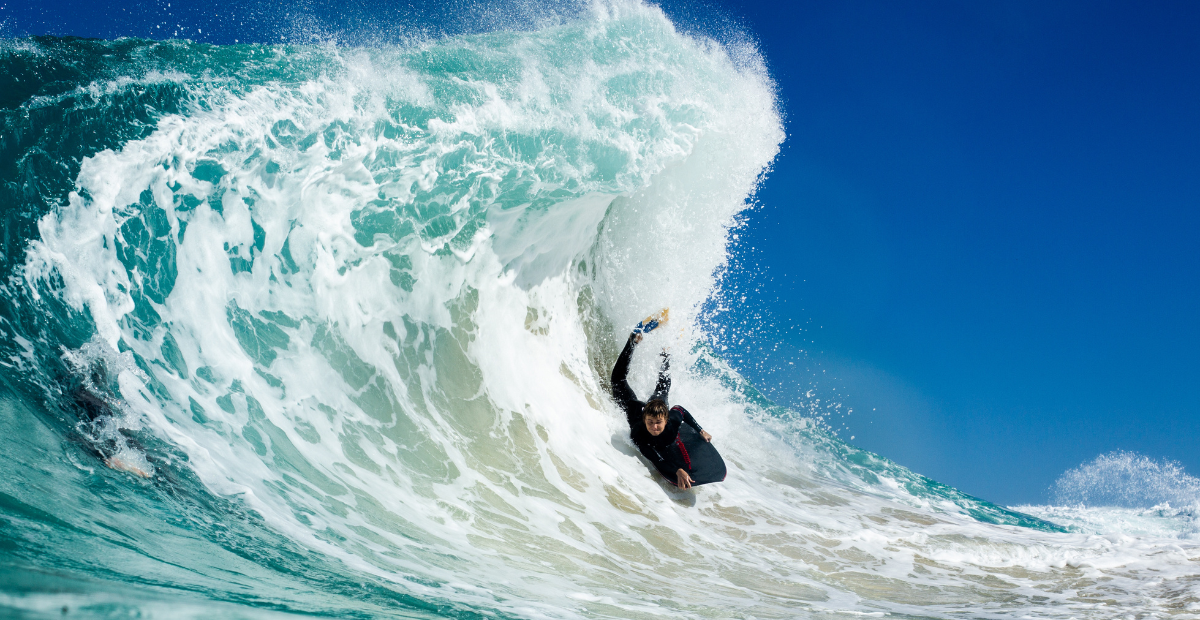
Prone (Laying down, standard riding)
- Prone bodyboard riding is the most common style of riding where the bodyboarder lays down flat on top of their board.
- This is the riding style that 99% of bodyboarders begin with, so the majority of bodyboards are designed for prone riding.
- The prone bodyboard shape generally has its widest point further forward towards the nose to support the upper body of a rider that mainly lays down (Goes prone) while riding.
- Prone or standard bodyboards come in a variety of sizes to accommodate different sized riders and or wave conditions.
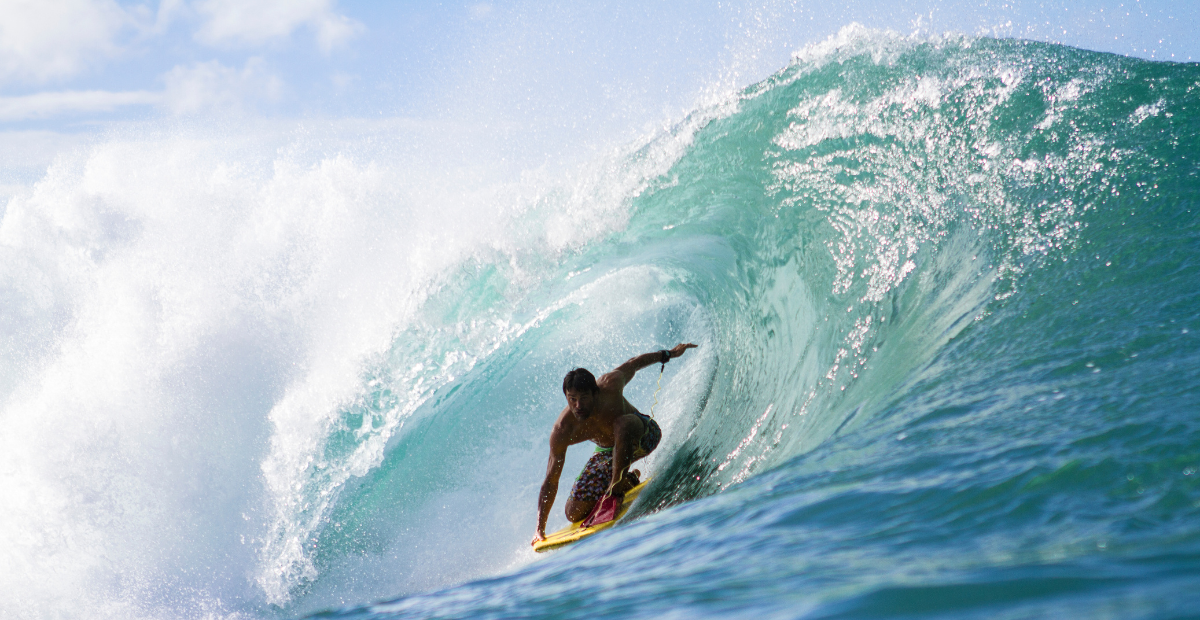
Drop Knee
- Blending the sports of bodyboarding, surfing and knee boarding, drop knee bodyboarding is a unique riding style where a rider puts one foot near the front of the board, places their opposite knee towards the tail of the board, and lets their swim fin hang off the back of the board in the water.
- Intermediate to advanced riders are more likely to have success bodyboarding in the drop knee style.
- A drop knee board shape is characterized by a lower wide point halfway down the board and a narrow tapered nose. This helps with weight distribution as riders with a drop knee stance have most of their weight towards the back of the board.
Combo
- Boards with a combo shape are the most versatile.
- They can be used for both Drop knee and Prone styles of riding.
Stand Up
- Most similar to surfing, this style of bodyboarding is when a rider stands upright on a bodyboard while riding a wave.
- The riding style and tricks are similar to surfing both on the face of a wave and in the air. Stand Up Bodyboards will typically be longer, stiffer, narrower, and have more volume to provide more similar performance to that of a surfboard.
Bodyboard Sizing Factors
“What size bodyboard should I buy?” is one of the most common questions new customers ask our staff. When referring to bodyboard size, you mainly want to focus on board length, unless you are wanting to ride stand up or drop knee. Choosing the right bodyboard length for your size is extremely important for all riding styles though.
If your bodyboard is too long for your height and proportions, your knees will hit the board tail while kicking with your swim fins. A board too large for you will also be difficult to control and swim efficiently with. A board that is too small for your size won’t offer enough flotation. This will slow your speed in the water, cause a dragging/sinking effect, and make it difficult to catch waves. Finding the perfect board length for your size will save lots of unnecessary headaches and help you perform better in the water!
Sizing Factors to Consider
There are many factors to consider when choosing the right length board for you. Both your height and weight should be considered when deciding on a board size. For example, taller and heavier bodyboarders may want to size up on bodyboard length, as longer or wider and thicker boards offer more volume or floatation. There are also large rider specific bodyboards that are designed for extra flotation, durability, and flex strength. Smaller or lighter bodyboarders don’t have to worry about board volume or flotation as much depending on the length of the board.

The type of waves you’ll ride most often also play a big role in choosing your bodyboard size. For bigger barreling waves some riders prefer small boards as it is easier to turn into the pit (The area where the barrel forms). For smaller, mushier waves a longer board can be good as the extra volume and surface area will help you get into less steep waves easier.
Bodyboard Size Chart
Check out our sizing chart below for estimates that work for most riders and most bodyboard brands, but be sure to consider your body size, personal performance preferences, and double check your board sizing using the measurement methods below. What works for one person may not work for another, so some bodyboarders will ride different sized boards before finding the perfect fit.
Follow the chart below to see which size bodyboard could be best for you!
|
BODYBOARD SIZE CHART
|
||
|
Board Length (inches) |
Rider Weight (lbs) |
Rider Height (ft.' & in.") |
|
32" - 34" |
40 - 64 |
Under 4' |
|
36" - 38" |
65 - 85 |
4'-5' |
|
39" |
86 - 115 |
4'6" - 5'2" |
|
40" |
110 - 130 |
5'3" - 5"6" |
|
41" - 41.75" |
125 - 170 |
5'7" - 5'9" |
|
42" |
145 - 180 |
5'9" - 6'0" |
|
42.5" |
160 - 190 |
5'10" - 6'2" |
|
43" |
170 - 210 |
6'1" - 6'3" |
|
44" |
180 - 270 |
6'2" - 6'4" |
|
45" |
195 - 255 |
6'3" - 6'6" |
|
46" |
220+ |
6'4"+ |
Still not sure which bodyboard size is best for you? Below are some additional methods that you can do at home or in our shop to help you choose the best bodyboard size for your needs.
Bodyboard Measuring: The Belly Button Method
- Take a tape measure or your bodyboard and measure from the floor to your belly button. Typically you want the nose of the board to come to your belly button.
- If you used a tape measure, take note of the measurement length and compare it to our size chart above.
- Be sure to consider your body proportions and if you find that the board is not reaching your belly button, or if it is way over your belly button, adjust accordingly.
- More often than not, as long as the board nose is relatively close to your belly button, you should be good to go!
Bodyboard Measuring: The Knee to Chin Method
- Hold your tape measure or board vertically in front of you, the tape measure or bodyboard should reach from your knees up to your chin.
- If your board doesn’t line up perfectly with your knees and chin, this is okay as long as it doesn’t seem too far off.
By using the size chart and these measuring methods, you should be able to find a perfect fit!
If you find that you are also interested in bodysurfing you don't need to worry about having a board or board sizing but we do have something for you... Our mini kick boards are great for bodysurfing as they can help you catch more waves and have more control on the face of the wave! One other tip for bodysurfers - invest in a good pair of swim fins and be sure to check out our swim fin buying guide to get everything you need to know about finding your perfect pair.
Bodyboard Cores
Although all bodyboard cores could be classified simply as, “foam”, not all bodyboards are created equal on the inside. The core materials and construction used in-between the slick bottom and top deck directly impact flex, recoil, durability, and the strength or rigidness of bodyboards.
Different core bodyboard materials offer different pros/cons and are created for different water temperatures, wave types, and body types. With all of this in mind, the core of your bodyboard is typically the first thing you should consider when evaluating which bodyboard models could be best for you.

We’ll cover the most common bodyboard core materials along with the latest core material technology and how they are ideal for different situations and riding styles.
Polystyrene Cores
Polystyrene cores represent the most affordable price point for bodyboards but they are generally the lowest quality core found in bodyboards. You can typically find polystyrene boards around the $20 price range in tourist shops or gas stations near a beach. These kid friendly boards provide an introduction to the sport without a huge investment for those wanting to use the board for a handful of days at the beach. Just don't expect a long life span with older kids or frequent use from this bargain build of board!
Expanded Polystyrene (EPS) Cores
EPS is primarily a beginner level core that typically costs less than $100. EPS has come a long way in the past few years. It isn't the most durable of the cores as it can crease or fold (break on itself) on larger wave days, under larger riders, or when put through rough conditions. However, EPS cores are very lightweight and have been made to be more durable with high end features like stringers, stiffeners, and deck contours. EPS boards can be a great option for beginners, kids, or older bodyboarders riding more mild waves.
Polyethylene (PE) Cores
The original core used for the first bodyboards, PE is also the most commonly used. The PE core gives the bodyboard flex which generates projection and instant response for the rider. PE is also good for colder water conditions, since low water temperatures increase the stiffness of all cores. The flex attributes of Dow™ PE allow the rider to contort and manipulate the board to harness the power of the wave and transfer that power into projection.
We Now Offer Three POLYPROPYLENE (PP) Cores
KINETIC CORE™ 1.9lb PP ULTRA (K19)
Kinetic Polypro Core is a state of the art engineered bodyboard core. A lightweight core that is fusion formed to create a nucleus that delivers incredible flexural properties, including instant recoil, added projection, enhanced longitudinal stiffness & awesome compression strength. This core is 100% waterproof.Constructed from premium grade 1.9lb density Polypropylene resins, Kinetic Core delivers amazing projection and response as a result of high pressure cell-fusion created during the blank manufacturing process. Kinetic Core is a warm water core available in various reinforcement configurations, each tuned-in for specific wave condition.
KINETIC 1.5lb PP (K15)
Developed using cutting-edge expansion cell technology, K15 is slightly lighter/ softer than Kinetic 1.9lb PP. Perfect for cooler water temps like Northern California, it is a cool water core specifically formulated to meet key performance characteristics as demanded by our worldwide team of the sports elite riders. It's great for riders looking for a bit more flex but not a pool noodle. K15™ gives you an even better mix of flex, recoil, projection and pop.
LITEFLEX 1.2lb PP (LFX)
A lightweight, affordable PP core that is best suited for cold water and grom boards under 40”. Not suitable for warm water temps. The most flexible of all 3 PP cores on the market.
Kinetic Core 1.9lb PP ULTRA (K19) W/ Parabolic PFS-T
Kinetic Polypro Core is a state of the art engineered bodyboard core. A lightweight core that is fusion formed to create a nucleus that delivers incredible flexural properties, including instant recoil, added projection, enhanced longitudinal stiffness & awesome compression strength. This core is 100% waterproof. Constructed from premium grade 1.9lb density Polypropylene resins, Kinetic Core delivers amazing projection and response as a result of high pressure cell-fusion created during the blank manufacturing process. Kinetic Core is a warm water core available in various reinforcement configurations, each tuned-in for specific wave condition.
NRG+ cores are lower density PP Cores. This Low density PP Core is designed to have the lightweight strength & stiffness of PP core but with more flex like a PE Core. NRG Core is 1.5lbs PCF (Per Cubic Foot) - This means they are lighter than other PP cores as the NRG Core cells are larger and less dense. This is a great core choice if you want more flex in cold water or in general a performance board that has more flex. This core can also be great for kids or beginners as the additional flex can make it an easier core type to control.
As you can see there’s more than meets the eye with the core materials of a bodyboard! Be sure to explore all core options to see which could be best for your needs.
Bodyboard Tail Shapes
Besides the crescent tail shape that most are familiar with when thinking of a bodyboard, there are a variety of tail shapes that have been developed over the years. The tail shape that you choose can directly impact your speed, turning, control, hold on a wave, and maneuverability.
Understanding the strengths of each tail shape design helps bodyboarders pick the right tail shape for their wave riding style and performance preferences. The oldest and most popular tail shape is the crescent tail, but more modern shapes such as the bat tail, or brand specific tail shapes, have grown in popularity and offer different benefits. Let’s cover each shape and how their performance differs.
Crescent Tail (Also Called a Clipped Crescent Tail)
Crescent tails or clipped crescent tails are the industry's most popular tail shape. A crescent tail in exact shape terms has a 385 degree radius cut taken out of the tail of the bodyboard.
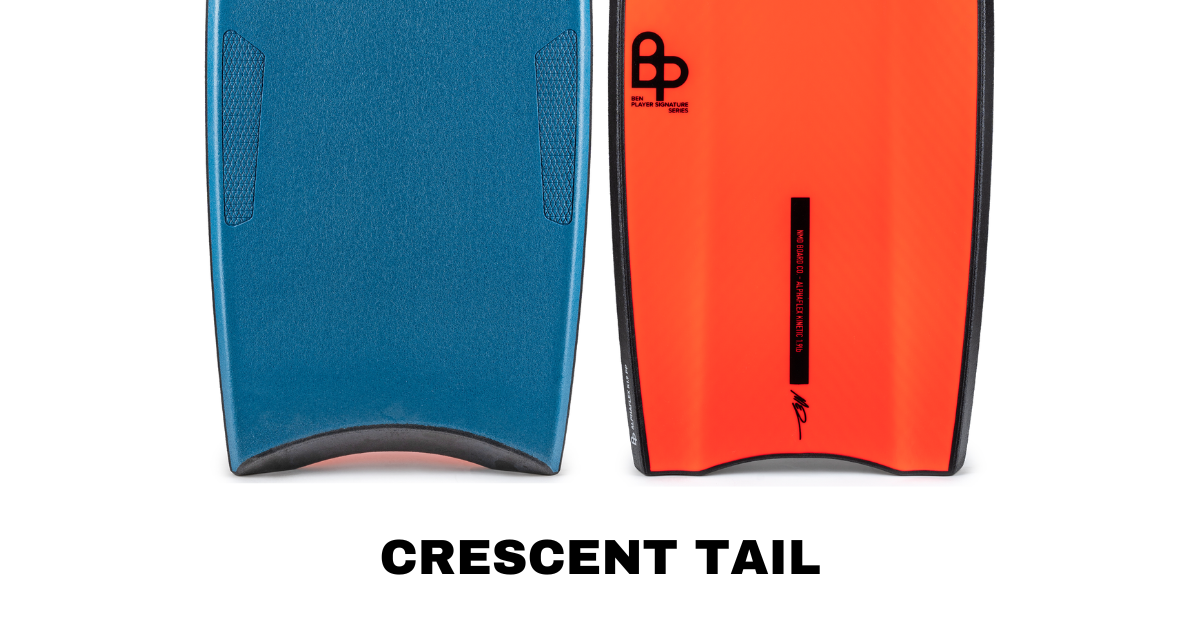
The crescent tail allows the rider to comfortably sit inside the rails of the board. This provides stability while making the rail the longest edge of the bodyboard to help riders hold in the wave face. Crescent tail's are the go to for most prone and drop knee riders as it is a very versatile shape. The crescent tail is highly maneuverable and allows the core to flex while bottom turning, which provides great recoil and projection.
Full Crescent Tail
Full crescent tails are the bodyboard tail of choice for dropknee and versatile riders. The key difference between standard crescent tails and full crescent tails lies with the points or corners of the tail.
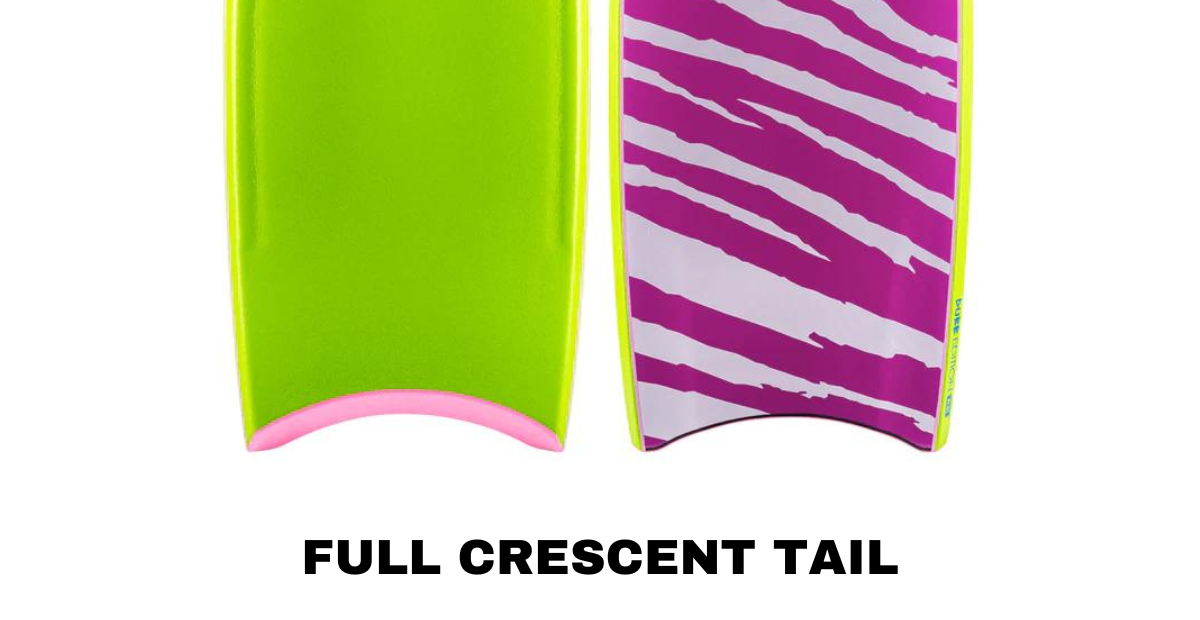
The sharper points of the tail allows the rail to sink further into the face of a wave for extra hold. This helps riders hold a line with only their trailing fin in the water behind them.
Bat Tail
The bat tail shape earned its name due to its resemblance to an outline of a bat.
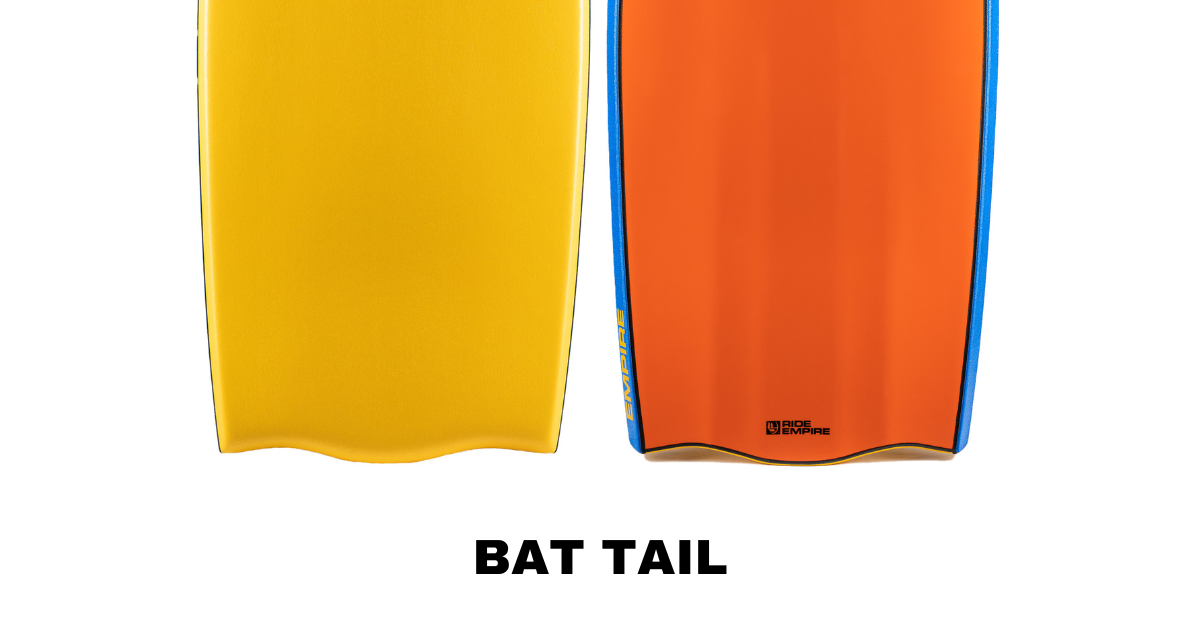
The protruding bulb increases the boards planning surface at the tail area for down the line speed with wings that lock the tail in throughout turns. In general, bat tails are looser which provides less control, but makes it easier to do spin tricks such as 360’s.
Delta Tail
Delta tails are an extreme bat tail, meaning their shape is more pronounced. They have more volume and surface area than a crescent tail, which can mean more speed and buoyancy.
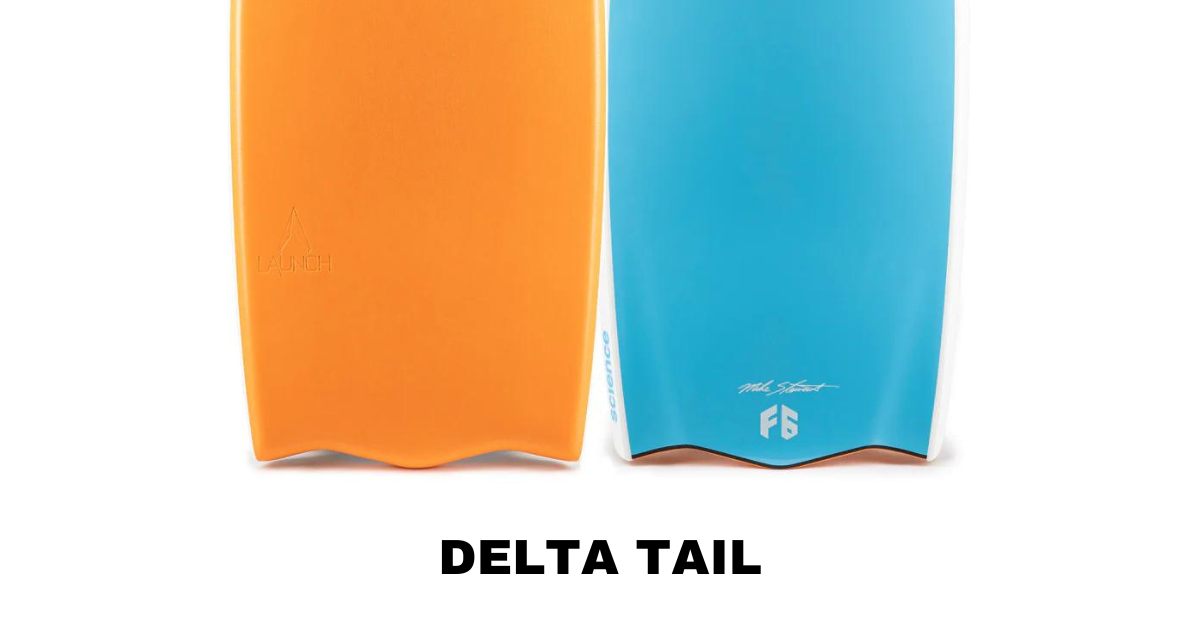
Delta Tails excel in fast down the line waves and are great for clean lines and long drawn out turns. The delta tail makes the board "sit up" in turns rather than dig in (like a crescent tail) which means you can't turn quite as sharp but you'll come out of turns faster.
Tri-Crescent Tail
The Tri-Crescent trail earns its name for having three crescents - two small crescents on the outside and one large crescent in the center of the board.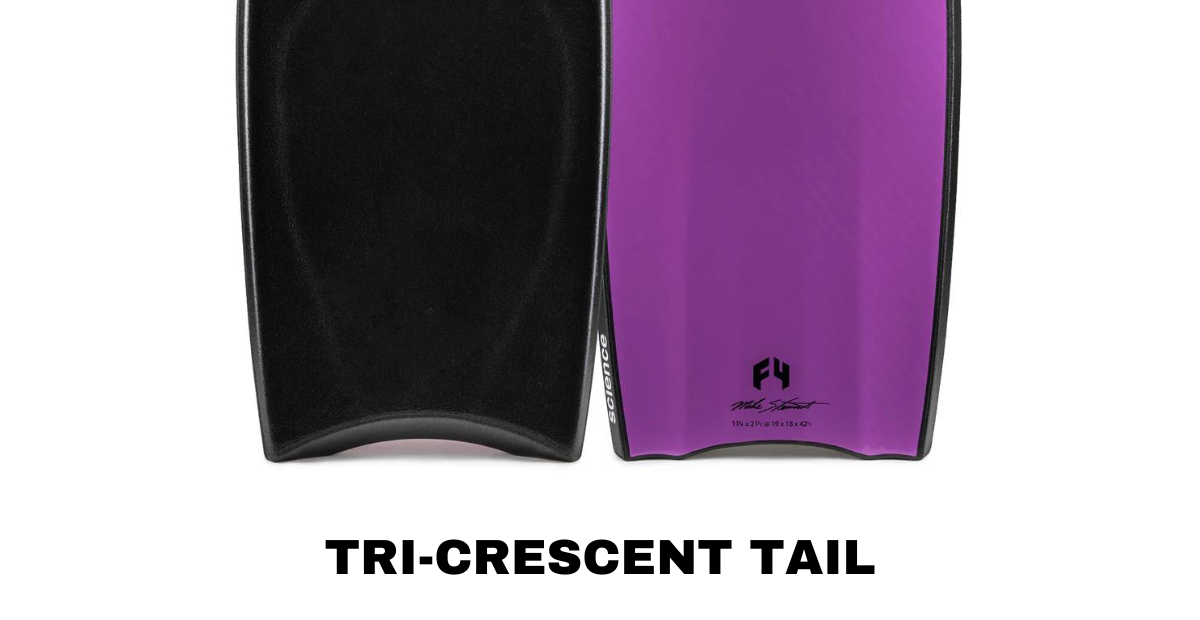
You can't really see the small crescents from the top of the board, but when flipped over, they are easier to notice on the bottom of the board. The extra points between the crescents that enables you to turn sharper but still keep hold and drive on the face of the wave.
WIFLY V2 Tail
The WIFLY TAIL is a progressive tail design incorporating the hydrodynamic flow from the Quad Concave for more positive traction during bottom turns and lip drives.
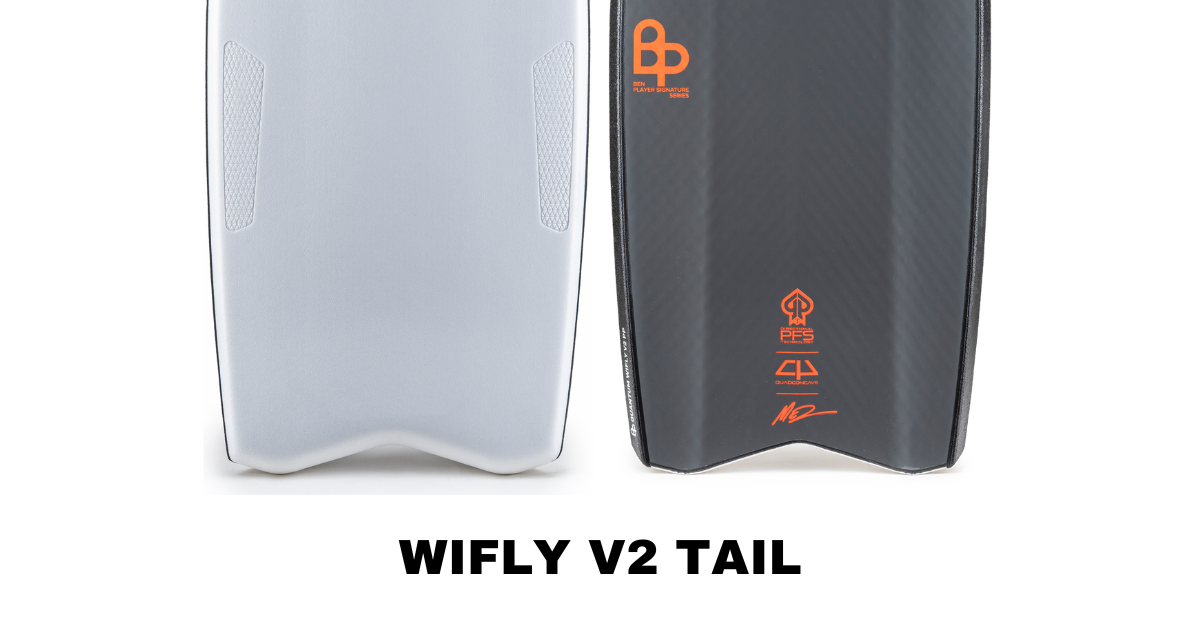
The aggressive Deep V tail's slightly shorter rails and the angled point from the tip of the tail to rails allows for better release and works in conjunction with the Quad Concave to release in tight spins & pocket moves. In the testing phase it was found that the Deep V removed a lot of volume from the tail area, so to compensate for the reduced volume there is an added 1/2” to length without changing nose, wide-point and tail widths. So if you ride a 41.5” in crescent tail you will ride a 42” in the WiFly V2.
While these are some of the most common and popular bodyboard tails available on the market, you may see different options available as different bodyboard manufacturers are always experimenting with different tail shapes and designs!
Bodyboard Stringers
Just like in a surfboard, modern bodyboard manufacturers may add stringers to boards. Stringers are rods used to add strength, increase stiffness and help maintain good rocker. This means that stringers help lengthen the life of a bodyboard by offering extra durability.
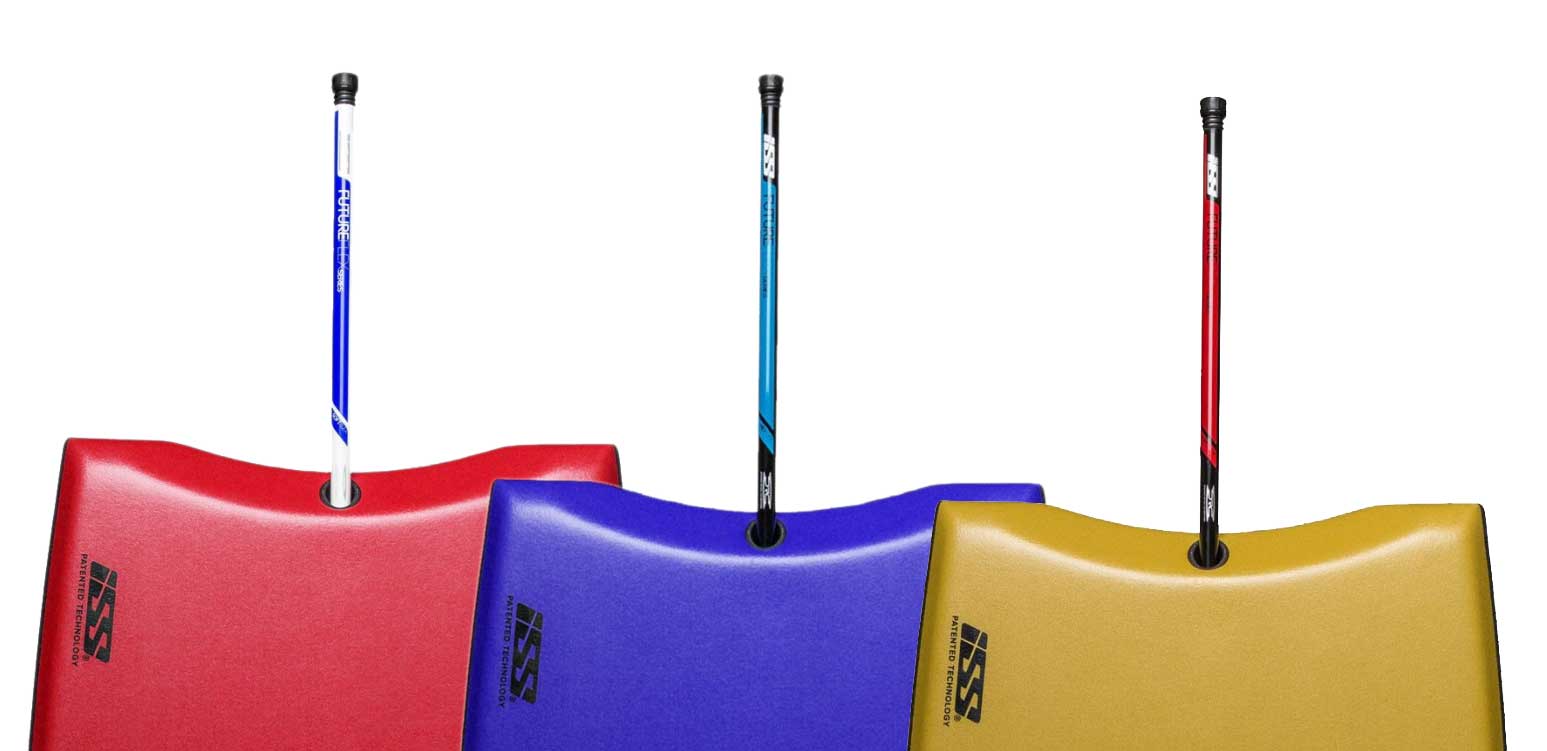
Stringers are generally inserted into the center of the core. They normally start at the tail and end 6" from under the nose of the bodyboard. Stringers are made of many different designs and materials. Bodyboards can have anywhere from 1 to 3 stringers. Stringers also affect flex or recoil but board technology, such as the ISS Stringer System, allow bodyboarders to control the level of flex that the stringers provide within their board.
Popular Stringer Options
CFT Stringer
High-grade filament wound composite-fiber tube for increased board strength and spring-like recoil.
EXT Stringer
High-strength, epoxy fiber tubes for increased stiffness and board life.
Trident Stringer System
Prone Setup: 1 x full-length central CFT stringer, combined with 2 x shorter stabilizing stringers positioned 5″ either side of centre and 12″ down from the nose. The stabilizing stringers enable us to increase the strength of the board through its midsection, without making the overall flex too rigid.
Drop Knee Setup: 1 x full-length central CFT stringer, combined with 2 x shorter stabilizing stringers positioned 5″ either side of centre and 22″ down from the nose. The low positioning of the stabilizing stringers enable us to increase the strength of the board through its tail section, perfect for DK carves and for driving off the bottom
ISS® - Interchangeable Stringer System
The ISS® – Interchangeable Stringer System revolutionizes bodyboarding by giving the rider the freedom to fine tune the flex of their board to better suit the wave and water conditions. Using patented ‘load and lock’ technology, ISS® stringers are inserted and removed with the turn of a key. The ISS® range of stringers utilize the latest in composite construction and manufacturing technology to create a quiver of shafts that covers virtually the full spectrum of a riders flex requirement.
Do Stringers Prevent Creasing or Folding?
Stringers will not prevent your bodyboard from creasing or folding, meaning stringers will not make your board indestructible but they will surely enhance the longevity of a board. It should also be noted that you need to be sure to check for stringer placement when installing a leash plug into your new board. The last thing you want is to damage or break a stringer when drilling a leash plug hole!
Bodyboard Stiffeners & Constructions
Built around or within the core materials of bodyboards is different core technology, referred to as stiffeners or constructions. Stiffeners or constructions are dependent on the manufacturer of the bodyboard, but they are essentially core material enhancements, foam beams, structural support materials, and the most popular material used is mesh.
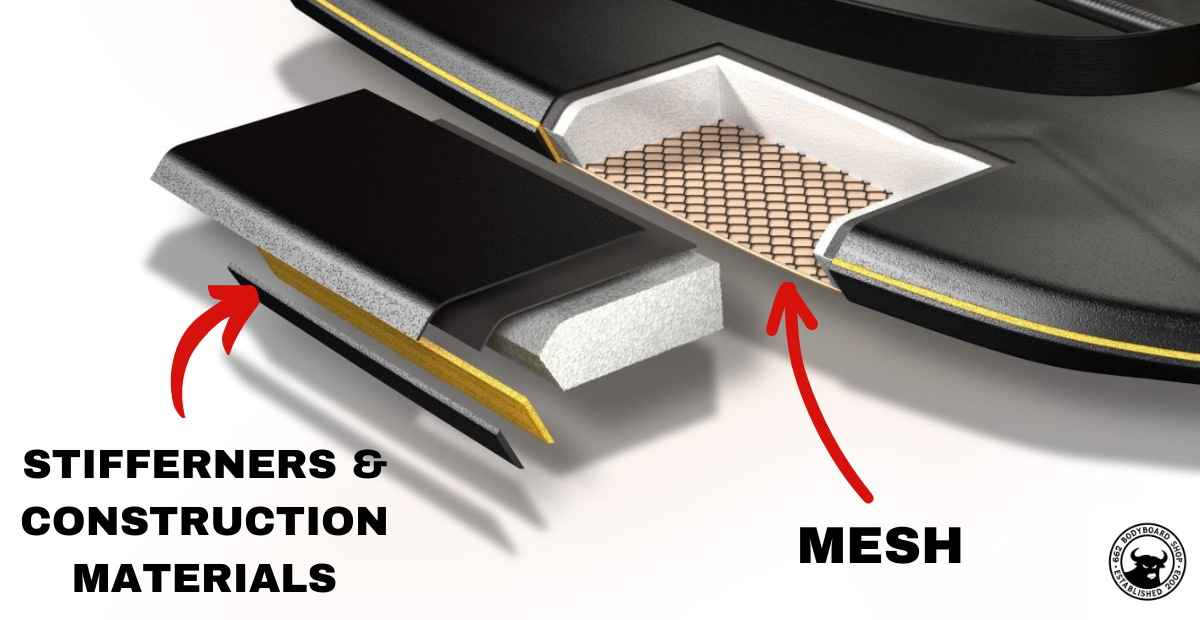
Bodyboard Mesh
Mesh is essentially a thin wire-like sheet of plastic (Most commonly nylon), that looks similar to chicken wire as it has a diamond pattern. This pattern and the strength of the plastic creates an even layer of casing that is sealed onto the core, either on the bottom side, or on the top side, or both sides. The seal that the mesh provides the core enhances projection, increases the durability of the board, and helps the board retain its shape or prevent over-flexing. Besides mesh, there are a variety of popular brand specific construction technologies that we’ll cover next.
Tension Tech Technology
Tension Tech is a top mesh sub sandwich layer. It consists of a sheet of mesh sandwiched in between the two crosslink polypropylene layers. This allows us to produce a much thinner core without sacrificing strength, resulting in an incredibly strong board with excellent recoil and spring-like projection. Combined with Polypro, this makes an extremely stiff board, perfect for tropical locations.
Alphaflex (Kinetic PP Ultra w/ Parabolic Gen 3 PFS Core, NMD Bodyboards)
Alphaflex represents NMD's next core evolution. By integrating the all new Kinetic Ultra 1.9lb, a higher modulus PP core, with our exclusive PFS-T technology, Mez has engineered a board without the need for a traditional tubular stringer. The end result is a ride that delivers a more direct torsional flex for incredible projection off the bottom and drive throughout hard carves. Alphaflex is specifically designed for elite riders wounderstand the intricacies between flex and speed. Available in Crescent and Wifly V2 tail options.
Parabolic Base (VS Bodyboards & NMD)
Based on our groundbreaking Parabolic Flex System technology, the ProRide™ range of boards feature a Parabolic Base™ for revolutionary strength-to-weight performance allowing you to ride a thinner board without a loss in nose to tail stiffness. Parabolic Airex T90 high-density structural foam beams are embedded vertically into the base of the core for unrivaled flex-to-recoil energy transfer. Scientifically proven Vapor Tracks track water along the length of the beams creating a hydrodynamic effect through the center of the board for electric board speed.
Radial Flex (Pride Bodyboards)
Radial Flex® was developed using the latest CAD software with integrated Generative Structural Analysis, allowing us to observe how a board reacts under typical wave riding load and flexion. The data showed us that when the rider pulls up on the nose of the board, the resulting structural load is directed through to the elbow in a radial pattern, and not in a direct line from hand to elbow. Based on these findings we have developed the Dynamic Arc® technology. Constructed from a single beam of lightweight, high-tensile Divinycell structural foam, the Dynamic Arc® has been configured to disperse the structural load along its vertical surface. By extending the natural curve of the Dynamic Arc® through to the tail of the board, we were also able to create a unique load-bearing frame that not only enables instant transfer from compression load to projection, but also distributes impact stresses, such as those caused by heavy landings, along the entire length of the frame.
Quad Core (Hubboards Bodyboards)
The Hubboards Quad Core has four times the performance of any regular core. They fused two layers of engineered polypro core around a layer of tension tech mesh suspension. By adding surly slick, bottom mesh & a woven graphite stringer to these core's the final result is a core that responds like 2 core's in one. The quad core produces twice the projection & offer's twice the durability. With Jeff's refined signature shape & CNDC Deck the Quad Core plus is the most advanced board on the market & exclusive to Hubboards.
PFS III Parabolic Flex System 3rd Generation
Similar to the PFS2 technology but PFS3 high-density aerospace foam beams run in a straight orientation from tail to nose. This gives the board more longitudinal flex right out of the box, without sacrificing the exceptional strength the PFS boards have become renowned for.
Bodyboard Flex & Recoil
Besides the core material that you choose, stringers and stiffeners will also directly affect the flex or recoil of your board, making all of these features intertwined. For beginners, you don’t need to worry about flex or recoil as much. For intermediate to advanced riders who are looking to perform at a higher level, getting a feel for flex and how it affects your ability to control your board, perform turns, gain speed, and project up the face of a wave, will allow you to take your riding to the next level.
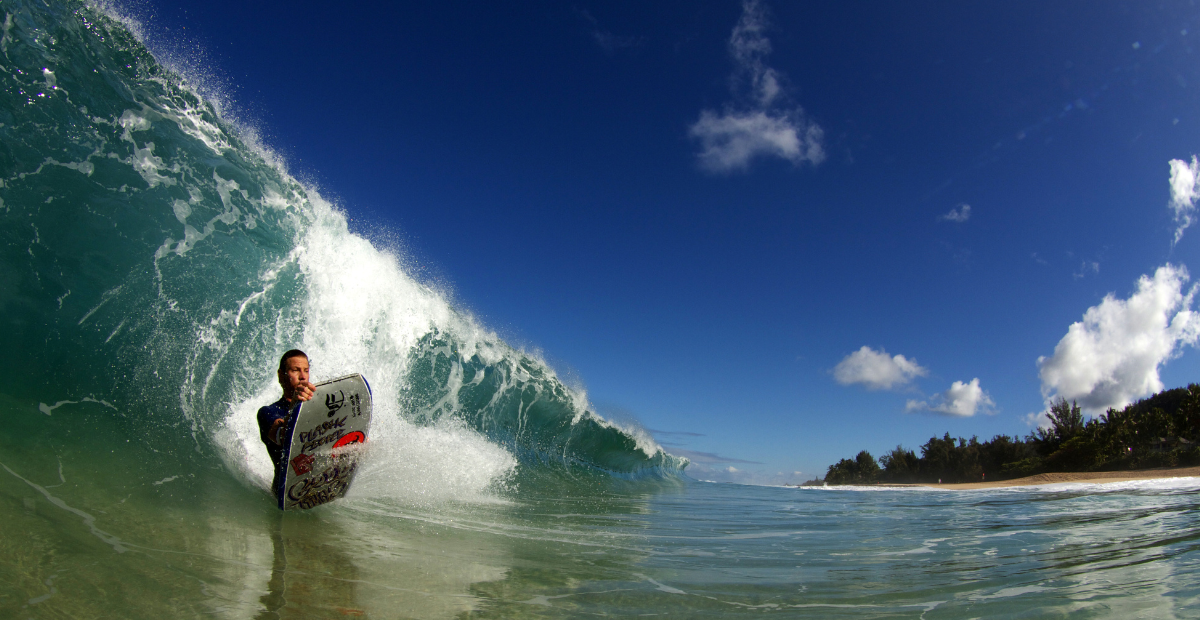
So what is flex or recoil then? Flex/recoil is what it sounds like - How much your board flexes, bends, and recoils back to its original shape. Quality modern bodyboard materials are built to withstand this pressure and are designed to provide a certain amount of flex and recoil with a board.
The power of waves is immense. There is a large amount of pressure between the water and a person on a bodyboard. Think about how much force is on a board with an adult rider turning sharply up the face of a large wave. The board wants to flex or bend naturally during the turn, which is ideal as this allows the board to better grip the wave, gain speed, recoil, and project the rider up the face of the wave with more force. Once the board and rider have completed their turn or have cleared the wave, the board returns to its rigid or original state.

Over time, bodyboards will flex and recoil more with use, meaning the rigidness of the board becomes less strong. Less rigidness is often ideal though for many riders, as more flex and recoil means better performance, so a break in period for a new board is common.
Over time and with a lot of use, too much flex or recoil will make the bodyboard more prone to creasing, which is actually desired by a lot of riders. Creasing is when the core of the board flexes enough to create a visible crease in the slick bottom of your board. Too much creasing over time, will make a board more prone to folding though, or essentially having a board break on itself, which means the end of the life for the board.
With enough use, all boards will eventually crease, break, or fold, but for the most part, quality bodyboards should last a long time for the wave size and rider size that they are designed for. As you can see, making sure that your board has the right features to support you physically and also meets your flex preferences is important for board longevity and maximizing your performance in the water. Flex and recoil are more of a board feel type of thing for more intermediate to advanced riders performing bottom turns, aerials, or flips. But the sooner you get a feel for flex, the sooner you will realize how important it is for advancing your bodyboard skills.
Channel Configurations
Channels are located on the slick bottom of the board. Channels are grooves that move from the tail of the board (deepest and widest groove section) to the nose of the board (Least deep and thinnest groove section, or no groove section). Channels primarily affect your turning ability but they also affect speed and water flow. Channels are much more important for control and maneuverability when riding large waves.
If you are a beginner rider chasing smaller waves, you don’t need to worry about channels as much. For those advanced riders out there or bodyboard science nerds wanting to learn about the newest channel configurations, we’ve got you covered! With bodyboard manufacturers offering different channel designs to meet different performance needs, selecting the right channel design can have a big effect on performance. Let’s dive into some of the latest options.
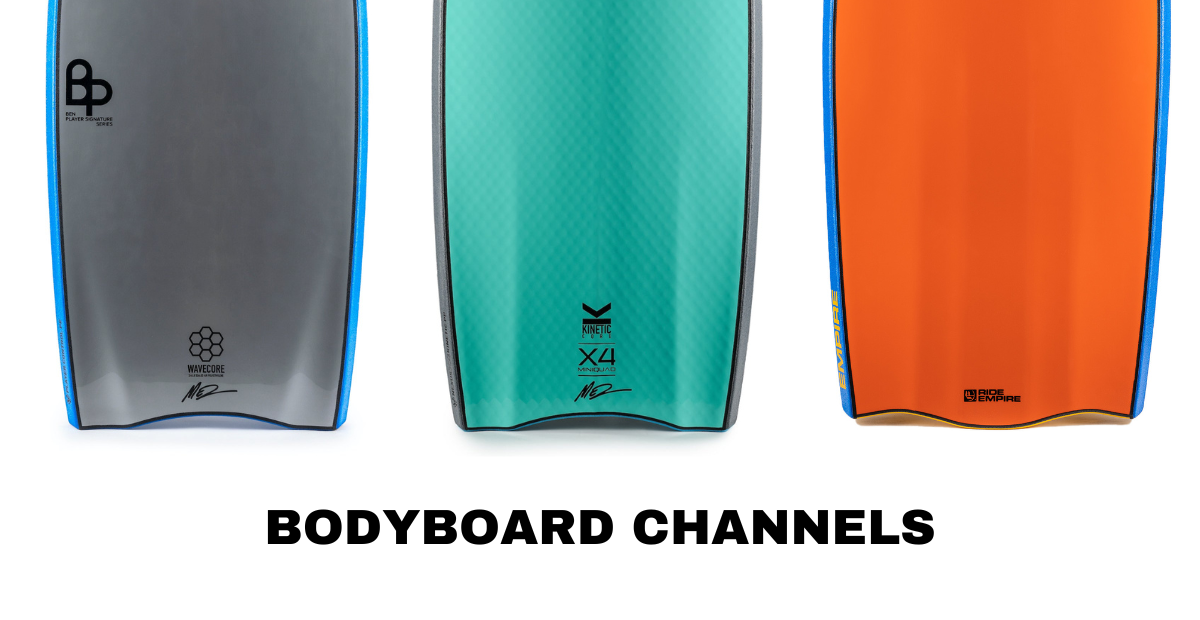
Two of the most common types of channel configurations include:
Graduated Channels
Some form of graduated Channels are used for most EPS, PE & PP Boards. These channels start off thin at the nose end & gradually widen until the tail. Bodyboard channels help hold the tail of the board in to avoid side slipping on the wave face. Most if not all boogie boards come with channels of some sort these days.
Parallel Channels
Parallel channel's run parallel to the rails & are slightly wider than most channels. These channels are slightly graduated to capture more water & direct it out through the tail of the board resulting in more speed, hold in the wave face & release when you need it.
Brand specific, high performance channel options include:
Quad Concave (NMD Bodyboards & VS Bodyboards)
The Quad Concave can be broken down into two parts:
- Central Double Concave - Tracks laminar (water) flow through the centre of the board keeping you higher on the wave face, which allows you to generate more speed into your bottom turns.
- Outer Venturi Channels - Draws the laminar flow from a wider entry point into a narrow exit through the tail. Based on Bernoulli’s principle, the laminar flow increases in speed as it progresses through the channel, giving you more drive.
The Quad Concave is precision shaped on our custom built AKU CNC shaping machine. The AKU gives us the ability to design progressive channel and concave set-ups with incredible accuracy and consistency previously not possible by hand shaping.
X4 Mini Quad Concave (NMD & VS)
The X4 Mini Quad takes the key design factors of our groundbreaking full-length Quad Concave and shrinks it down, focusing on the back half of the board. Starting below the wide-point, the X4 essentially splits the hull in two, combining the glide and flow of a flat bottom with the drive and directional control of the Quad Concave. The X4 Mini Quad is designed to excel in small to medium size surf and for quicker transitions closer to the pocket of the wave.
The Quad Concave is precision shaped on our custom built AKU CNC shaping machine.The AKU gives us the ability to design progressive channel and concave set-ups with incredible accuracy and consistency previously not possible by hand shaping.
Tri-Quad Vent Concave (Science Bodyboards)
The New Tri-Quad Channel Tail combo is a on or off Channel System. It engages when you need it and has a normal ride in cruise mode.The Four Channels are narrow and deep with a flat section in centre to help give you a bit more release when you need it. Push hard on your rail and the quads rip in with hold and drive and combined with the Tri Crescent hooks in the First and Fourth Channel this allows you to turn sharper and still keep the hold and drive your after.
3/2 Concave (Empire Bodyboards)
The 3/2 Concave is constructed with a split triple Concave to optimize speed and control w/ two interior venturi Channels for maximum responsiveness and engagement on the wave face. Concaves One, Three, and Five all have increased depth, width, and length to serve as hulls to produce more hydrodynamic lift which results in maximum speed and drive. The two inner (two & four) channels are designed to optimize stabilization and engagement on the wave face to produce maximum laminar flow resulting in the most proficient channel system ever created by Empire.This unique channel system permits for a quick and responsive feel for line adjustments while trimming and driving down the line. The 3/2 Concave System is precision shaped on a custom built AKU CNC shaping machine. The AKU gives Empire the ability to design progressive channel and concave set-ups with incredible accuracy and consistency previously not possible by hand shaping.This board is designed with two things in mind: Speed + Control.
SDC (Pride Bodyboards)
Some very basic fluid mechanics principles have been adapted to our case by our Pride Lab engineers. “When the water flow goes from a bigger section to a smaller section, the flow speed decreases and the pressure increases.” figure 1. explains Jeremy Arnoux. “Using this principle as an analogy to what happens below our boards (if water is coming from both side of the board), if the perimeter of the concave narrows, water will encounter resistance at the end of the concave creating a pressure which push up the board creating more lift. As a result, having a concave will add a greater sense of lift. Which also means more speed in smaller conditions." The Double Concave is coupled with the classic deep Hull channels.
SDC+ (Pride)
Our new SDC+ technology enhances grip on the face of the waves and enables greater control in hollow sections.Thanks to a light gradual concave AKU shaped on the lower third of both rails, this technology will help you scoop with ease at your local slab, giving you the most control in hollow waves. On the other hand, the concave rails won’t affect your speed and trajectory when you are on the glidingphase,making the most of your Single to Double concave bottom contour. SDC+ will provide you with as much lift and speed in small condition as our SDC boards. The best of both worlds.
SCI-Five (Hubboards Bodyboards)
The Sci-Five Concave bottom to greatly increase the board's overall speed, control and responsiveness. This happens as water is rapidly pushed through the 5 tight hydrodynamic channels creating cavitation which gives lift in the tail thus minimizing friction which reduces drag which equals increasing speed. When riding on your rail the Sci-five channels are engaged to give you heavy duty traction with out any sacrifice for maneuverability. The gradual 18 inch channels are narrow, and they also stop well short of the center of the board, this is designed specifically in order to allow you the freedom to spin, launch and carve in and around the pocket with ease.
Slick Bottoms
As reviewed briefly earlier in this guide, the slick bottom is the bottom of the board that touches the water. The slick bottom seals the bottom of bodyboards, helps boards retain their shape, and generate speed in the water. The two most common plastics used to create slick bottoms are Surlyn and HDPE (High-density Polyethylene).
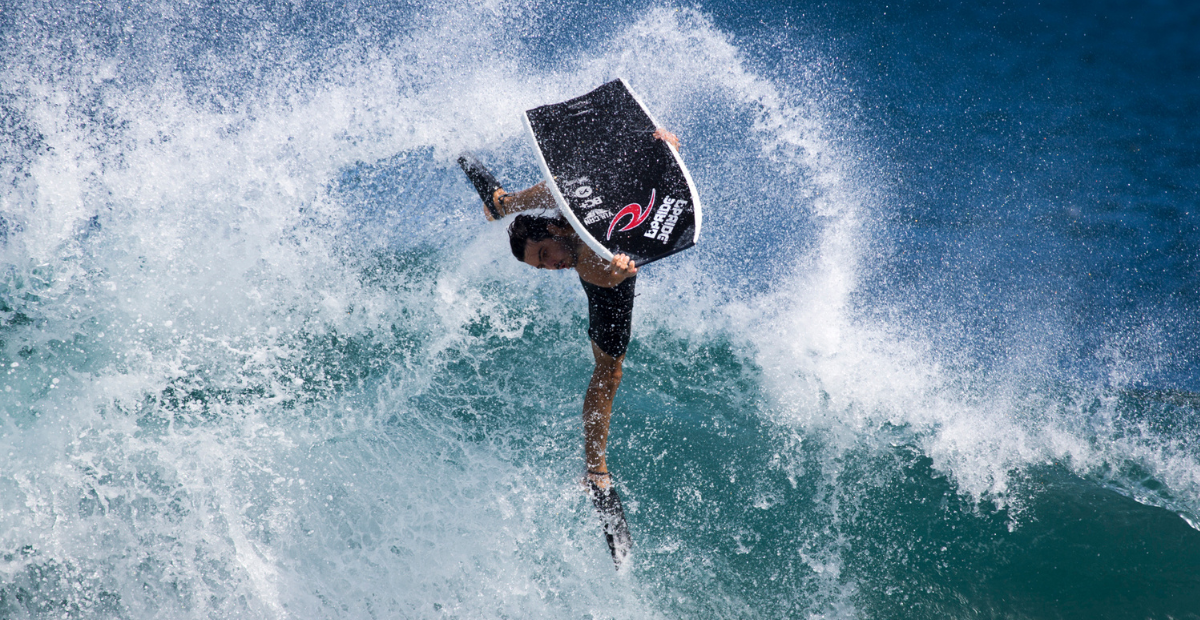
Surlyn
Surlyn is a unique, rubber like combination of ethylene resins and other copolymers invented and manufactured by the chemical geniuses at DuPont. Unlike rigid plastics, Surlyn has amazing flexural stiffness that allows a board to conform and contort to the curve of the wave when controlled by applied pressure from the rider. When the torque is released, the dynamic memory properties of the Surlyn deliver instant recoil, projecting the board onto the next section. Surlyn is so strong that it is used as the cover for golf balls due to its unique abilities to resist cutting and abrasions from golf club impact. Surlyn is the slick of choice for high end bodyboards.
HDPE (High-density Polyethylene)
The cheaper alternative to Surlyn slick is an HDPE slick. In terms of look and feel there’s little to separate it from Surlyn. However, HDPE slicks tend to appear on entry-level or beginners boards so unless you’re just starting out it’s usually worth paying that little extra for a Surlyn. Saying that, smaller and lighter riders tend to get away with HDPE slicks as they exert less pressure on the board. This means longevity isn’t as affected for smaller bodyboarders. The HDPE skin is less performance-based to give great value for money while you increase your skill level.
Although slicks are important, the channel configurations built into slick bottoms generally have more of an effect on board performance.
Rail Configurations
The rails are the side edges of a bodyboard. There are two parts, the rail which is the lower proportion of the edge and the chine which is the part that wraps around onto the deck. The most common rail and chine proportions are 60/40, 50/50, and 55/45.
Image of Rail
- A 60/40 rail means a larger rail surface area vs chine surface area, or approximately 60% of the rail will be in contact with the water, with 40% remaining for the chine. A 60/40 rail is great for those who want more control or maneuverability, but you will sacrifice speed a bit. 60/40 rails are most popular with advanced bodyboarders pursuing large waves.
- A 50/50 rail is an even split in rail vs chine surface area, or 50% rail vs 50% chine. The 50/50 rail is a little bit faster than the 60/40 rail but will offer less control and grip on a wave.
- A 55/45 rail gives a little more edge to the rail, which offers a little more control, but doesn’t sacrifice as much speed as the 60/40 rail. This is a great all around rail configuration for most types of waves and riding styles.
Remember that control and speed work together. Without control you will turn less efficiently. If you can’t turn efficiently, you’ll sacrifice being able to gain speed on the face of a wave, so it is always important to consider a rail design that matches what types of waves you’ll be riding and meets your personal preferences.
Single & Double Rails
Single and double rails mean that there are either one or two layers of foam running down the edge of each side of the board. By adding an extra layer, the rail can be stiffened up which helps to give extra strength to the board's edge. This helps to give the board durability and a bit more speed. If you are looking for a higher quality board, try to go with double rails.
Top Deck Materials, Contours, & Grips
The top deck of a bodyboard is the soft foam material that you lay on, drop knee on, or stand up on to ride the board.
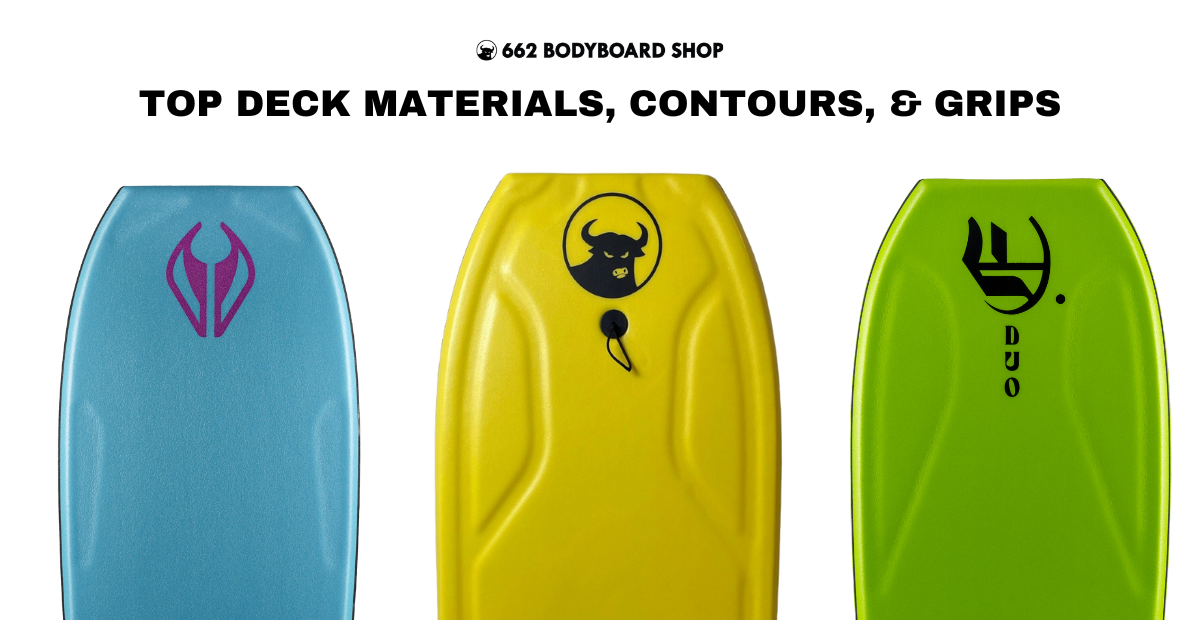
For high quality boards, you shouldn’t need to research top deck materials too much, as most manufacturers use polyethylene. However, there are some top deck materials and ergonomic designs that we find to be great options due to their durability, ability to avoid water absorption, and enhanced grip that they provide:
NXLPE WaveCushion
8lb Non-Crosslink Polyethylene outer skins. The premier top deck skin
IXLPE WaveDeck
Irradiated Crosslink Polyethylene outer top deck skins feature a super-fine cell structure with less than 1% water absorption.
Traxion Deck Contours
Dual purpose deck contouring. Specifically designed to create dedicated flex zones for torsional and nose-to-tail response and integrated with functional grip enhancement.
Bull Grips
Die-cut foam bulbs are positioned at each corner of the nose to enhance finger grip. Now with a new, curved contour for an even better handle.
GripTech
Thermoformed textured grips promote superior wax build up for enhanced hand traction.
Bodyboard Leashes
Most bodyboard manufacturers will include a bodyboard leash with a new board in their packaging. Depending on the brand or quality of board that you choose, this will either be a wrist leash, bicep leash, or ankle leash. Each leash type suits different bodyboarder preferences and riding styles.
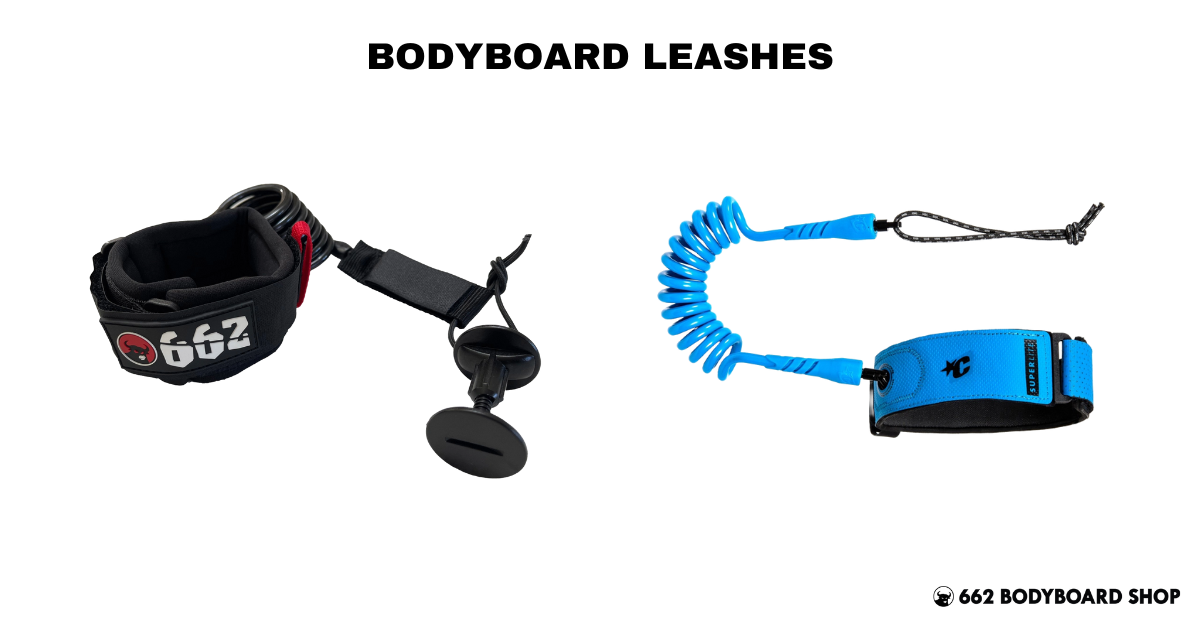
The majority of entry level boards will come with a standard, non coil wrist leash that is already attached to the board. High performance boards will also typically come with a wrist leash, but the key difference is that the leash, and leash plug (The screw insert that goes through the core and acts as the anchor for your bodyboard leash), will not yet be attached to your board. This allows you to install the leash plug wherever you prefer on the board according to your riding style needs.
Although the majority of bodyboards come with a wrist leash, this does not mean that you have to use that specific leash for your new board. Coil or spring wrist leashes are generally a better choice over straight non-coil wrist leashes, as the coil on the leash offers a spring like recoil when your leash is pulled hard (Think about wiping out and having your board pulled away from you) - This in turn helps alleviate or soften the tension on your leash and board, which can help you avoid extra strain on your arm and potential damage to your leash plug or board.
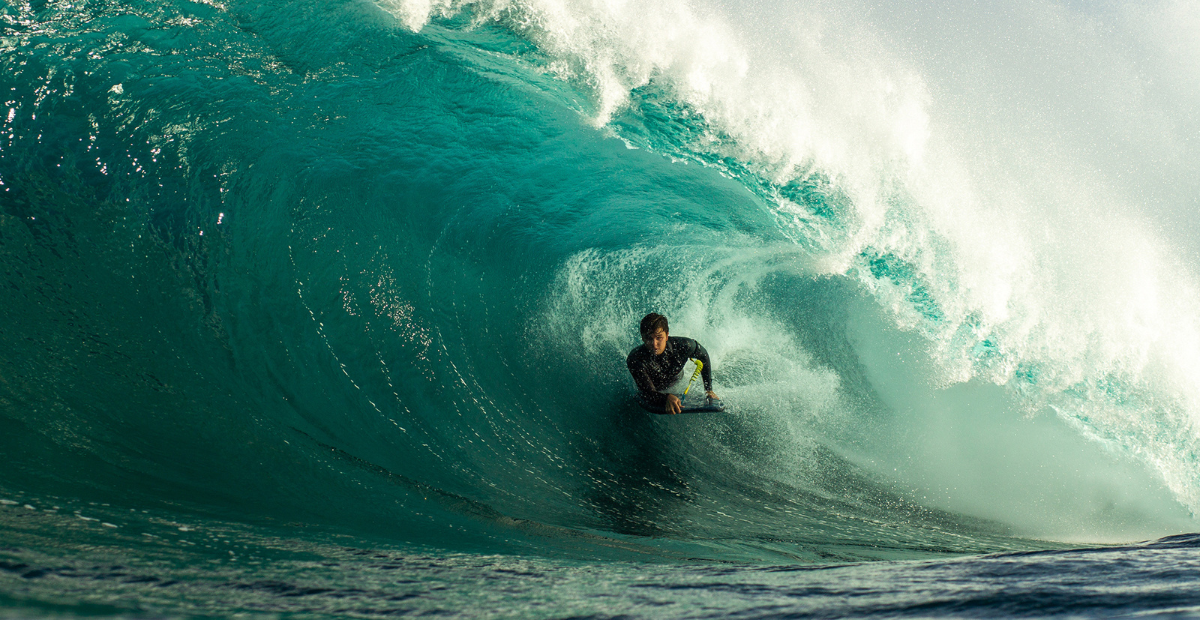 In larger waves, a coil or spring leash is highly recommended over a standard straight leash as the force of the waves pounding against your board can cause a forceful yanking action, leading to the leash snapping, or the leash plug being torn out of your board, creating a large hole that can lead to water damage if not properly repaired. You’ll notice that we only sell coil leashes for a reason!
In larger waves, a coil or spring leash is highly recommended over a standard straight leash as the force of the waves pounding against your board can cause a forceful yanking action, leading to the leash snapping, or the leash plug being torn out of your board, creating a large hole that can lead to water damage if not properly repaired. You’ll notice that we only sell coil leashes for a reason!
Bicep leashes are the standard for most intermediate to advanced prone bodyboarders, as this leash type allows for riders to paddle with their arms more efficiently. By attaching to your bicep, the leash is more out of the way while performing your swim stroke. If you have ever tried to paddle with your upper body on a bodyboard while using a wrist leash, you know that it feels somewhat awkward, creates more pull on the board, limits your stroke range, and can generally lead to more board control mistakes while chasing waves. In larger waves, utilizing your arms to paddle is typically a must as this can help you swim faster, get into waves easier, better perform duck dives, and avoid crashing sets or other riders in the lineup.
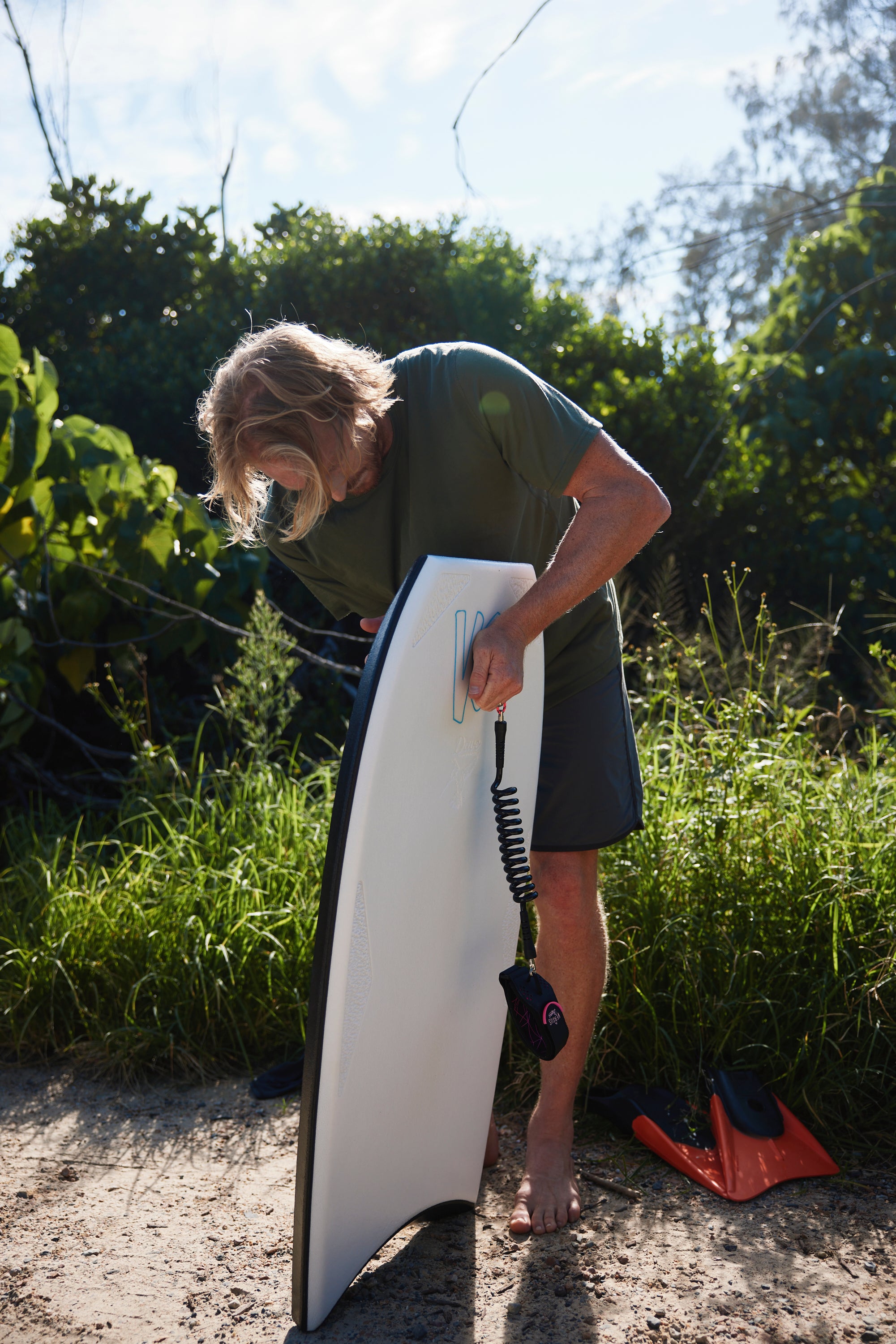
Lastly, some bodyboarders will place their leash towards the tail of their board which suits ankle leashes. This is what you would see on a surfboard for example and this style of leash is used by some drop knee and stand up bodyboarders. Some drop knee bodyboarders will place their leash in the standard position towards the nose and will use a wrist leash. Some stand up bodyboarders will opt to not use a leash at all. It’s all by preference, and in general, coil/spring wrist leashes are used as ankle leashes, since the wrist and ankle are similar in size on most people, and there is no speciality needs for an ankle leash.
Final Steps for Selecting a Board
So now you know all there is to know about bodyboards! Ready to start choosing the perfect model for you? Don’t worry. If you’re still unclear about anything or need more information about bodyboard features then be sure to contact us. We’re ready to help find the perfect bodyboard for you!

